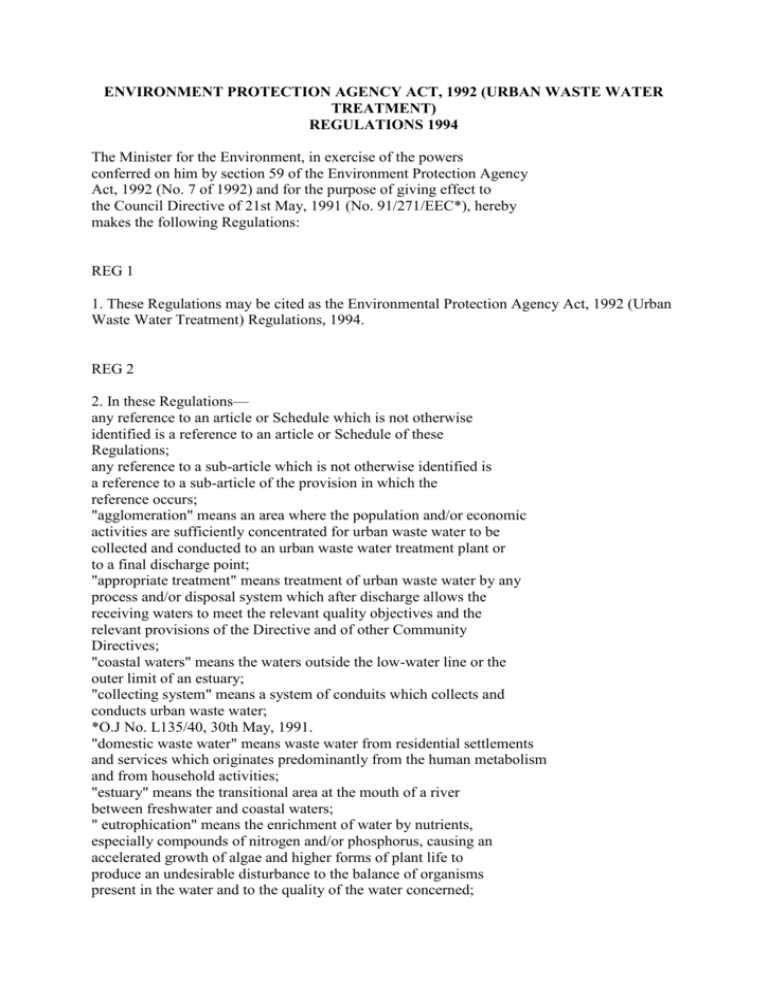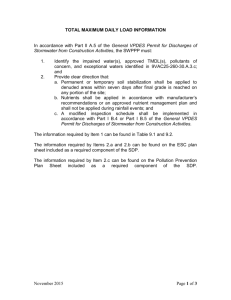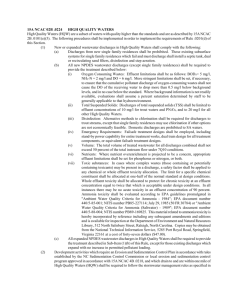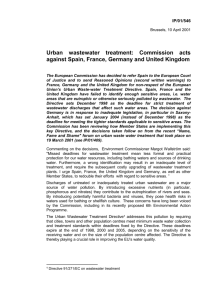ENVIRONMENT PROTECTION AGENCY ACT, 1992 (URBAN
advertisement

ENVIRONMENT PROTECTION AGENCY ACT, 1992 (URBAN WASTE WATER TREATMENT) REGULATIONS 1994 The Minister for the Environment, in exercise of the powers conferred on him by section 59 of the Environment Protection Agency Act, 1992 (No. 7 of 1992) and for the purpose of giving effect to the Council Directive of 21st May, 1991 (No. 91/271/EEC*), hereby makes the following Regulations: REG 1 1. These Regulations may be cited as the Environmental Protection Agency Act, 1992 (Urban Waste Water Treatment) Regulations, 1994. REG 2 2. In these Regulations— any reference to an article or Schedule which is not otherwise identified is a reference to an article or Schedule of these Regulations; any reference to a sub-article which is not otherwise identified is a reference to a sub-article of the provision in which the reference occurs; "agglomeration" means an area where the population and/or economic activities are sufficiently concentrated for urban waste water to be collected and conducted to an urban waste water treatment plant or to a final discharge point; "appropriate treatment" means treatment of urban waste water by any process and/or disposal system which after discharge allows the receiving waters to meet the relevant quality objectives and the relevant provisions of the Directive and of other Community Directives; "coastal waters" means the waters outside the low-water line or the outer limit of an estuary; "collecting system" means a system of conduits which collects and conducts urban waste water; *O.J No. L135/40, 30th May, 1991. "domestic waste water" means waste water from residential settlements and services which originates predominantly from the human metabolism and from household activities; "estuary" means the transitional area at the mouth of a river between freshwater and coastal waters; " eutrophication" means the enrichment of water by nutrients, especially compounds of nitrogen and/or phosphorus, causing an accelerated growth of algae and higher forms of plant life to produce an undesirable disturbance to the balance of organisms present in the water and to the quality of the water concerned; "industrial waste water" means any waste water which is discharged from premises used for carrying on any trade or industry, other than domestic waste water and run-off rain water; "population equivalent" is a measurement of organic biodegradable load and a population equivalent of 1 (1 p.e.) means the organic biodegradable load having a five-day biochemical oxygen demand (BOD5) of 60g of oxygen per day — the load shall be calculated on the basis of the maximum average weekly load entering the treatment plant during the year, excluding unusual situations such as those due to heavy rain; "secondary treatment" means treatment of urban waste water by a process generally involving biological treatment with a secondary settlement or other process in which the requirements established in Part 1 of the Second Schedule are respected; "sensitive areas" means those areas specified in the Third Schedule and such other areas as may be identified pursuant to Article 5 of the Directive; "sludge" means residual sludge, whether treated or untreated, from urban waste water treatment plants; "the Directive" means Council Directive 91/271/EEC of 21st May, 1991 concerning urban waste water treatment, and references to other Community Directives are references to Directives other than Council Directive 91/271/EEC; "urban waste water" means domestic waste water or the mixture of domestic waste water with industrial waste water and/or run-off rain water. REG 3 3. (1) Subject to sub-articles (2) and (3), a sanitary authority shall provide a collecting system for urban waste water— ( a ) by 31st December, 1998 for every agglomerations with a population equivalent of more than 10,000 which discharges into any of the sensitive areas specified in the Third Schedule or into the relevant catchment areas of such sensitive areas, ( b ) by 31st December, 2000 for every agglomeration with a population equivalent of more than 15,000, ( c ) by 31st December, 2005 for every agglomeration with a population equivalent between 2,000 and 15,000. (2) A collecting system required under sub-article (1) shall satisfy the requirements of the First Schedule. (3) Sub-article (1) shall not apply where the provision of a collecting system is not justified either because it would produce no environmental benefit or because it would involve excessive cost, provided that the sanitary authority is satisfied that individual systems or other appropriate systems are used which achieve the same level of environmental protection. REG 4 4. (1) In the case of urban waste water entering collecting systems, a sanitary authority shall provide treatment plants which provide for secondary treatment or an equivalent treatment— ( a ) by 31st December, 2000, or such later date, not being later than 31st December, 2005, as the European Commission may agree pursuant to a request under Article 8 of the Directive, in respect of all discharges from agglomerations with a population equivalent of more than 15,000, ( b ) by 31st December, 2005 in respect of all discharges from agglomerations with a population equivalent of between 10,000 and 15,000, ( c ) by 31st December, 2005 in respect of all discharges to freshwaters and estuaries from agglomerations with a population equivalent of between 2,000 and 10,000. (2) Notwithstanding sub-article (1) and subject to sub-article (3) and (4), a sanitary authority shall provide, by 31st December, 1988, treatment plants which provide more stringent treatment than secondary treatment or an equivalent treatment in respect of all discharges from agglomerations with a population equivalent of more than 10,000 into sensitive areas or into the relevant catchment areas of sensitive areas where the discharges contribute to the population of these areas. (3) Subject to sub-article (4), a discharge from a treatment plant required under sub-article (2) shall satisfy the requirements of Parts I and II of the Second Schedule. (4) Sub-articles (2) and (3) shall not apply in respect of individual treatment plants where the sanitary authority is satisfied that the minimum percentage of reduction of the overall load entering all urban waste water treatment plants in a sensitive area is at least 75 per cent for total phosphorus and for total nitrogen. REG 5 5. Notwithstanding the provisions of article 4, more stringent requirements than those specified in Parts I and II of the Second Schedule shall be applied to discharges from a treatment plant where this is required to ensure that the receiving waters satisfy any other relevant Community Directives. REG 6 6. (1) The water bodies specified in the Third Schedule are hereby identified as sensitive areas for the purposes of these Regulations. (2) Where, following a review of the identification of waters as sensitive areas pursuant to Article 5 of the Directive, the Minister identifies an area other than those in the Third Schedule as a sensitive area, then, as respects that area, the requirements of article 4 and article 5, as appropriate, shall be met not later than 7 years from the date such an area becomes identified as a sensitive area. REG 7 7. A sanitary authority shall ensure by 31st December, 2005 that urban waste water entering a collecting system shall before discharge be subject to appropriate treatment in the following cases: ( a ) in respect of discharges to freshwater and estuaries from agglomerations with a population equivalent of less than 2,000; ( b ) in respect of discharges to coastal waters from agglomerations with a population equivalent of less than 10,000. REG 8 8. (1) A sanitary authority shall ensure that a treatment plant provided in compliance with the requirements of these Regulations is designed, constructed, operated and maintained to ensure sufficient performance under all normal local climatic conditions. (2) Seasonal variations of the load shall be taken into account when designing a treatment plant. (3) A treatment plant shall be so designed or modified that representative samples can be obtained of the incoming waste water and of treated effluent before discharge to receiving waters. (4) A point of discharge of urban waste water shall be so chosen as to minimise the adverse effects on the receiving environment. REG 9 9. A sanitary authority shall take all such steps, as may be appropriate, in discharge of its functions under sections 16 of the Local Government (Water Pollution) Act, 1977 (No. 1 of 1977 ), as amended respectively by sections 12 of the Local Government (Water Pollution) (Amendment) Act, 1990 (No. 21 of 1990), and under section 97 of the Environmental Protection Agency Act, 1992, to ensure that the requirements of the Fourth Schedule are met with respect to the discharge of industrial waste water and shall review, and if necessary revise, any licence concerned at regular intervals. REG 10 10. (1) A sanitary authority shall carry out, cause to be carried out, or arrange for, the monitoring of: ( a ) discharges from urban waste water treatment plants in accordance with the procedures set out in the Fifth Schedule in order to verify compliance with the requirements of these Regulations, as appropriate, and ( b ) waters subject to a discharge from an urban waste water treatment plant where it can be expected that the receiving waters will be significantly affected. (2) The results of monitoring carried out under this article shall be transmitted to the Agency in such manner and at such times as the Agency shall direct. FIRST SCHEDULE Collecting systems A collecting system shall take into account waste water treatment requirements. The design, construction and maintenance of a collecting system shall be undertaken in accordance with the best technical knowledge not entailing excessive costs, notably regarding; — volume and characteristics of urban waste water, — prevention of leaks, — limitation of pollution of receiving waters due to storm water overflows. SECOND SCHEDULE Part I The values for concentrations or for the percentage of reduction shall apply. ParametersConcentrationMinimum percentage of reduction(1)Reference method of measurementBiocheical oxygen demand (BOD5 at 20° C) without nitrifiction(2)25 mg/1 0270—90Homogenized, unfiltered, undecanted sample. Determination of dissolved oxygen before and after five-day incubation at 20° C ± 1° C, in complete darkness. Addition of a nitrification inhibitor.Chemical oxygen demand (COD)125 mg/1 0275Homogenized, unfiltered, undecanted sample Potassium dichromate. (1) Reduction in relation to the load of the influent. (2)The parameter can be replaced by another parameter: total organic carbon (TOC) or total oxygen demand (TOD) if a relationship can be established between BOD5 and the substitute parameter. ParametersConcentrationMinimum percentage of reduction(1)Reference method of measurementTotal suspended solids35 mg/190— Filtering of a representative sample through a 0,45 um filter membrane. Drying at 105°C and weighing. — Centrifuging of a representative sample (for at least five mins with mean acceleration of 2,800 to 3,200 g), drying at 105°C and weighing. (1) Reduction in relation to the load of the influent. Part II Requirements for discharges from urban waste water treatment plants to sensitive areas which are subject to eutrophication. One or both parameters may be applied depending on the local situation. The values for concentration or for the percentage of reduction shall apply. ParametersConcentrationMinimum percentage of reduction(1)Reference method of measurementTotal phosphorus2 mg/1 P (10,000— 100,000 p.e.) 1 mg/1 P (more than 100,000 p.e.80Molecular absorption spectrophotometryTotal nitrogen(2)15 mg/1 N (10,000— 100,000 p.e.) 10 mg/1 N (more than 100,000 p.e.70-80Molecular absorption spectrophotometry. (1) Reduction in relation to the load of the influent. (2)Total nitrogen means: the sum of total Kjeldahl-nitrogen (organic N + NH3), nitrate (NO3) — nitrogen and nitrite (NO2) — nitrogen. THIRD SCHEDULE Sensitive Areas River Boyne, County Meath — 6.5 km section downstream of sewage treatment works outfall at Blackcastle, Navan, County Meath. River Camlin, County Longford — from sewage treatment works at Longford to entry into the River Shannon. River Castlebar, County Mayo — downstream of sewage treatment works outfall at Knockthomas to entry into Lough Cullin. River Liffey — downstream of Osberstown sewage treatment works to Leixlip reservoir, County Kildare. River Nenagh, County Tipperary — downstream of sewage treatment works outfall in Nenagh to entry into Lough Derg. River Tullamore, County Offaly — 0.5 km section downstream of sewage treatment works outfall in Tullamore. Lough Derg on the River Shannon. Lough Leane, County Kerry. Lough Oughter, County Cavan. Lough Ree on the River Shannon. FOURTH SCHEDULE Industrial Waste Water Industrial waste water entering collecting systems and urban waste water treatment plants shall be subject to such pretreatment as is required in order to: — protect the health of staff working in collecting systems and treatment plants; — ensure that collecting systems, waste water treatment plants and associated equipment are not damaged; — ensure that the operation of a waste water treatment plant and the treatment of sludge are not impeded; — ensure that discharges from treatment plants do not adversely affect the environment or prevent receiving waters from complying with other Community Directives; — ensure that sludge can be disposed of safely in an environmentally acceptable manner. FIFTH SCHEDULE Reference methods for monitoring and evaluation of results 1. Sanitary authorities shall ensure that a monitoring method is applied which corresponds at least with the level of requirements described below. Alternative methods to those mentioned in paragraphs 2, 3 and 4 may be used provided that it can be demonstrated that equivalent results are obtained. 2. Flow-proportional or time-based 24-hour samples shall be collected at the same well-defined point in the outlet and if necessary in the inlet of the treatment plant, in order to monitor compliance with the requirements for discharged waste water specified in these Regulations. Good international laboratory practices aiming at minimising the degradation of samples between collection and analysis shall be applied. 3. The minimum annual number of samples shall be determined according to the size of the treatment plant and be collected at regular intervals during the year: —2,000 to 9,999 p.e.:12 samples during the first year.four samples in subsequent years, if it can be shown that the water during the first year complies with the provisions of these Regulations; if one sample of the four fails, 12 samples must be taken in the year that follows.—10,000 to ·49,999 p.e.:12 samples.—50,000 p.e. or over:24 samples. 4. The treated waste water shall be assumed to conform to the relevant parameters if, for each relevant parameter considered individually, samples of the water show that it complies with the relevant parametric value in the following way: (a) for the parameters specified in Part 1 of the Second Schedule, a maximum number of samples which are allowed to fail the requirements, expressed in concentrations and/or percentage reductions in Part 1 of the Second Schedule, is set out in the Table to this Schedule; (b) for the parameters in Part I of the Second Schedule expressed in concentrations, the failing samples taken under normal operating conditions must not deviate from the parametric values by more than 100 per cent but, for the parametric value in concentration relating to total suspended solids, deviations of up to 150 per cent may be accepted; (c) for those parameters specified in Part II of the Second Schedule the annual mean of the samples for each parameter shall conform to the relevant parametric values. 5. Extreme values for the water quality in question shall not be taken into consideration when they are the result of unusual situations such as those due to heavy rain. TABLE Series of samples taken in any yearMaximum permitted number of samples which fail to conform4-718-16217-28329-40441-53554-67668-81782-95896-1109111-1251012614011141-15512156-17113172-18714188-20315204-21916220-23517236-2511825226819269-28420285-30021301-31722318-33423335-35024351-36525 GIVEN under the Official Seal of the Minister for the Environment, this 14th day of December, 1994. MICHAEL SMITH, Minister for the Environment. EXPLANATORY NOTE. These Regulations prescribe requirements in relation to the provision of collecting systems and treatment standards and other requirements for urban waste water treatment plants, generally and in sensitive areas. The Regulations identify 10 water bodies as sensitive areas. The Regulations also provide for monitoring procedures in relation to treatment plants and make provision for pre-treatment requirements in relation to industrial waste water treatment plants. These Regulations give effect to provisions of Council Directive No. 91/271/EEC of 21st May, 1991 concerning urban waste water treatment.







